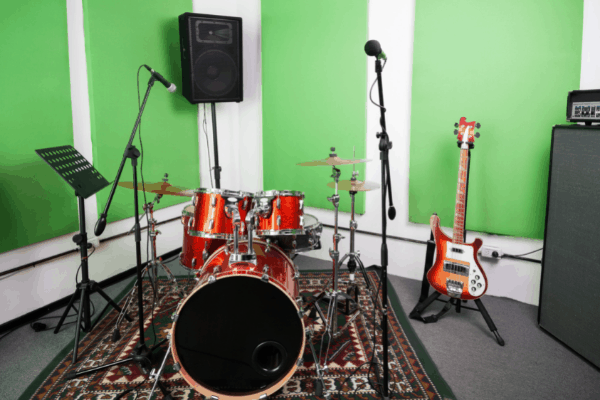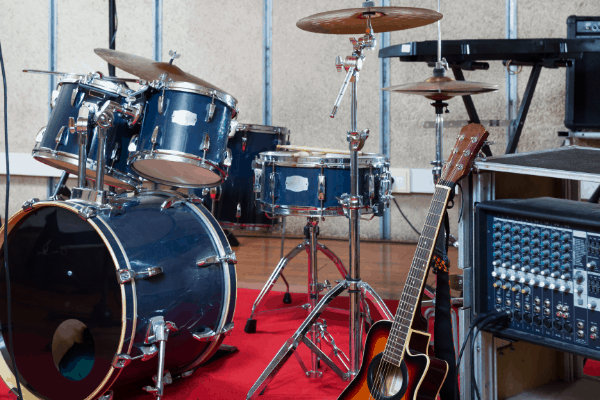If you’re recording and mixing your own music, you know how difficult it can be to simultaneously capture the drums and guitar. One solution is to record the parts at different times, but this isn’t always possible. What can you do to make sure that both the drums and guitar sound good in a simultaneous recording?
To record drums and guitar at the same time, make sure you’re recording in a big enough space to accommodate both instruments. Record the song using dynamic cardioid microphones. Then, fine-tune the recording in the mixing stage so that the drums don’t drown out the guitar.
This article will walk you through the best way to record drums and guitar at the same time.

Why Is Recording Drums & Guitar Simultaneously So Tricky?
If you’re at the beginning of your recording career and find yourself incredibly frustrated each time you listen to your home studio recording, know you’re not the only person struggling with this. Why is recording these two vital instruments in popular music so hard?
Subpar Recording Equipment
If you’re using the wrong microphones, only one microphone, or cheap microphones, your drums are going to drown out your guitar every time. When recording drums and guitars, you need to use high-quality cardioid microphones, not condenser mics.
There’s no way around the need for high-quality cardioid microphones. This article will explore some good recording mic options below.
Drums Are Loud
Very loud! There’s a reason parents dread the day their teenager asks for a drum kit. Playing the drums makes a lot of noise, and unless you have something like mesh drum tips or drum mutes, there’s just no way around that.
In any case, you can’t use drum mutes when making a recording. The noise from the drums tends to drown out the noise from all the other instruments.

Recording Space Is Too Small
While quality recording equipment is critical, some musicians miss the most vital aspect of making a quality sound recording: having a space big enough to accommodate all the instruments you need to record. The closer together all the musicians are playing, the muddier your mix will be.
If your recording space is slightly smaller than ideal, you might be able to counteract it with microphone placement and fabric dividers. If it’s a very tiny space, you will find it difficult to capture drums & guitar parts clearly.
Using an Amp Simulator
Rather than record both instruments totally live by setting up a drum kit, an electric guitar plugged into an amplifier, and a system of microphones capturing all the noise, some people decide to replace the amplifiers with amp simulators instead. Amp simulators are computer software that will imitate the sound of an electric guitar amplifier when a guitar is plugged in.
Some of the most popular kinds are Logic Pro X’s Amp Designer and BIAS Amp.
The amp simulators cut out the possibility of interference between the guitar and drums, creating a clean guitar part. Your guitarist will be able to keep time to the drums, but keep in mind that your drummer won’t be able to hear your guitarist.
However, an amp simulator is only a viable option for recording. Some bands prefer to keep their recording as close to “live” as possible, meaning an amp simulator won’t work for them. It all depends on what you want the record to sound like.
Still, you won’t want it to sound so muffled you can’t make out the music. If you still want to record the drums and guitar in the same space at the same time, read on to determine the best way to do it!
Get Quality Recording Equipment
One of the most critical elements of making any sound recording is quality recording equipment. Although you might not want the most expensive microphones, you’ll want to invest in them.
You’ll need to get cardioid microphones for both drums and guitars. Cardioid microphones are good at avoiding feedback from directions that the mic isn’t pointed in because of its “heart-shaped” sensitivity pattern.
Not all cardioid mics are created equal, however, so you’ll want to make sure you invest in ones that are widely trusted.
Best Drum Mics
You’ll want to work with a minimum of four cardioid microphones on your drumset, with one that goes next to the kick drum.
- The
Shure DMK57-52 Drum Microphone Kit
comes with three SM57 mics and one super-cardioid Beta 52A mic for the kick drum. It’s pricey at nearly $400 on Amazon but is one of the most popular drum microphone sets by far.
- The
PreSonus DM-7 Drum Microphone Set
actually comes with seven different mics to capture a complete sound. Despite this extra mic, the Presonus is more affordable than the Shure set. It’s a great option if you want more bang for your buck.
- (1) BD-1 cardioid dynamic microphone for kick drums and bass amps
- (4) ST-4 cardioid dynamic microphones with an adjustable rim-mounts for toms, snare, guitar amps,...
- (2) OH-2 cardioid small-diaphragm condenser microphone with clips and foam windscreens for drum...
Last update on 2025-05-30 / Affiliate links / Images from Amazon Product Advertising API
Last update on 2025-05-30 / Affiliate links / Images from Amazon Product Advertising API
Best Guitar Mics
Just like with recording microphones for drum sets, you’ll want to get a cardioid mic to capture your guitar playing.
- The
Shure SM58-LC Cardioid Dynamic Vocal Microphone
is popular with vocals and guitarists for its clarity and brightness. To use a Shure with an electric amplifier, place it approximately 1cm (0.39in) away from the amp’s face and about a third of the way from the end.
- The
Sennheiser e906 Supercardioid Dynamic Mic
is specifically designed for guitar amps, with a flat shape that will capture more sound. It records in the “sound characters” of bright, moderate, and dark.
- PERFECT FOR VOCALS: A highly effective, built-in, spherical filter minimizes wind and breath...
- UNIFORM CARDIOID PICK-UP PATTERN: Uniform cardioid pick-up pattern for maximum gain before feedback...
- PNEUMATIC SHOCK MOUNT: Handling noise gets absorbed by an advanced pneumatic shock mount system,...
Last update on 2025-05-30 / Affiliate links / Images from Amazon Product Advertising API
- SENNHEISER E 906 WIRED SUPERCARDIOID GUITAR BUNDLE INCLUDES: Percussion and Horns Microphone | MZQ...
- SUPERCARDIOID POLAR PATTERN: Tight focus on the sound source directly in front of the mic,...
- DYNAMIC CAPSULE: Rugged and handles high sound pressure levels without distortion, perfect for...
Last update on 2025-05-30 / Affiliate links / Images from Amazon Product Advertising API
Set Up in Your Recording Space
As noted above, if you have a home recording setup, you’ll want to have a big enough space to accommodate both instruments. If you’re recording in someone’s bedroom, there probably isn’t going to be enough space to make a decent simultaneous track.
If you find yourself stuck in a small recording space, however, you can do several things to improve the quality of the recordings.
Record in Different Rooms
Put your drum kit and your electric guitarist in completely separate rooms of your house. This might seem counterintuitive, but you want your drums as far away from other instruments as possible. Besides, they’re so loud that the other musicians should hear them no problem.
Put Artificial Walls Between Drums & Guitar
If you’re extra industrious (and don’t have extra room to put your drums in), you can set up an artificial wall between your drummer and the rest of your instrumentalists. You can do this with fabric like towels hung on a clothesline or even clothes closets. A little separation goes a long way!
Record & Mix the Track
Now that you’re all set up, it’s time to record the track! Keep in mind that the most critical element of a quality recording is the skill of the musicians. Seasoned drummers and guitarists will usually know the best way to capture their instrument’s sound.
It’s also helpful to get a talented sound mixer involved. Sound mixers will be able to do things like cut out certain frequencies to help clarify different instruments, cutting some of the muddiness from the song.
Check out my article about whether drums should be set up on carpet.
Final Thoughts
Recording drums and guitar simultaneously can be frustrating if you don’t know what you’re doing. Even groups with recording experience often find themselves with recordings ruined by booming drums and muddy guitar tracks. As long as you get a decent set of microphones and set up your space so that the two instruments don’t interfere with each other, you should be okay.
With these tips, you can streamline your recording process to make great-sounding musical tracks consistently.
Sources
- EHome Recording Studio: A Beginner’s Guide to Recording Guitar/Bass/Keyboards/Drums
- Wikipedia: Microphones
- Wikipedia: Amplifier modeling
Recent Posts
QuickTime is a vital app for many Mac users, and if you’ve recently bought a new microphone, you might wonder how to use it optimally. QuickTime cannot record audio content if it doesn’t have...
Every microphone leaves a unique signature on the quality of its output. If you’re a podcaster trying to melt your way into your audience’s hearts, a muddy, distorted recording won’t cut it....




